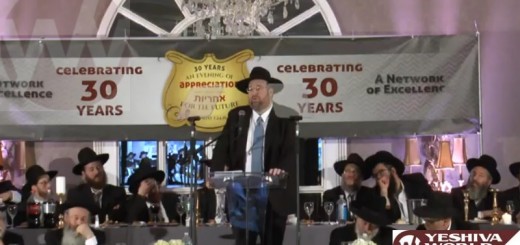Purim When Times Are Rough

Too many times in our recent collective memory the run-up to Purim was marred by catastrophes that were hard to ignore while trying to get into the spirit of the day. Twenty-five years ago many of us asked aloud, “How can we do more than go through the motions, when we just sustained the loss of the posek hador?” Three years ago, Purim followed on the heels of the Mercaz HaRav massacre. This year, it will require more consumption of alcohol to push the pictures of the Fogels out of our minds than to blur the distinction between arur Haman and baruch Mordechai. And if the contemporary Haman makes good on his threat, we may learn on Purim day of the destruction of the tomb of Mordechai and Esther in Hamadan by his Basiji goons. (He has already converted the site into one commemorating the holocaust perpetrated by Mordechai and Esther the Jews against the innocent Persians.)
I have collected some pirkei machshava that address the problem, directly or tangentially. Presenting them earlier at a shiur was cathartic. I hope that those in real and virtual audiences might also find some chizuk in some of the material that follows.
The simplest approach owes to someone who could write the textbook on catastrophe and suffering – and in fact did so. One Purim during the worst of times in the Warsaw Ghetto, Rav Kalonymus Kalman, the Piasetzner Rebbe, was asked by some of his Chassidim how they could celebrate amidst the horrors that surrounded them. He responded with his trademark conviction: “All of you know that Chazal speak of Yom ki-Purim, that a Yid can enjoy more aliyah through the avodah of Purim that that of Yom Kippur. What if you decided one year that you were not in the mood to fast on Yom Kippur? Would you seriously entertain such a possibility? Surely you would tell yourselves that the Ribbono Shel Olam commands us to fast, and we will obey, whether we find it agreeable or not. The Ribbono Shel Olam instructs us to be happy on Purim – and we must obey, whether we find ourselves so disposed or not.”
On one level, our question is irrelevant. Halacha dictates that we must be happy on Purim. Sitting down to a seudah with that mindset will be effective for some people.
While it may work for some people, others will still be skeptical, wanting a roadmap that describes the journey from reflective misery to unbridled joy. Our first, almost instinctive reaction to them is to remind them that Purim is the Yom Tov of galus. Our exile and troubles do not end with the conclusion of the Megilah. We are still, as the gemara has it, avadim to Achashverosh. Galus is never pretty. (When it seems acceptable, we are in the worst sort of trouble, because we then do not act forcefully enough to extricate ourselves from it.) Purim reassures us that in the worst of times, Hashem has not abandoned us, and will not do so. Whatever else we endure, this bond between Him and us is cause for celebration, for huge displays of joy. A subset of those emotions of joy is the realization that we have nothing in common with the barbarians who plague us.
A rebbi and mentor of mine years ago offered me words of chizuk before a Purim beset with tragedy in the community. He asked me why the Jews of Shushan escaped the original gezerah brought upon them in Heaven for whichever aveirah prompted it, as discussed in gemara Megilah. I offered the usual answers from the standard works based on Chazal: tefilah, bitachon, etc. I made the case for each one. He declined them all. He believed that any theme that isn’t clearly expressed in the text of the Megilah might be important for us to dwell upon, but inadequate to explain the turnaround of Purim. The text does not point to a critical response by the Yidden. We have to assume that the Megilah’s key message is that HKBH wants us, no matter what. He will not abandon us. Looking at the challenges that face us, and painfully aware of our spiritual warts and blemishes, this has to be a comforting thought.
The Chasam Sofer offers support for those who refuse to be comforted. He asks how we can lose ourselves in such merriment on Purim, oblivious to the human toll it took. Esther may have been a heroine, but her life was tragic. She never had a typical Jewish family, never escaping the Persian court. The Megilah begins, in Chazal’s description, with Achashverosh making sacrilegious use of the kelim of the beis hamikdosh to demonstrate his subjugation of the Jewish state. Nothing in the Megilah answers that outrage.
The Chasam Sofer does not offer consoling thoughts, nor does he minimize the problem. He lets the question stand. He argues that we do not look upon the story with rose-colored glasses, ignoring what we do not want to see. Rather, he says, we give the tragic elements the attention they deserve. They are included in Taanis Esther, and in the pesukim of the Megilah that we read with the tune of Eichah.
Perhaps we could enlarge upon his argument by stating that this model is one that has faithfully worked for us in galus. We find much to celebrate in Hashem’s protection behind the scenes, while always conscious of the terrible price that we are still forced to pay.
Elsewhere, the Chasam Sofer presents a thought that is more disturbing than comforting, but may work for some. The Gemara links Esther with the ayeles hashachar of Tehilim. “Just as the morning star means the end of night, so is Esther the end of [biblically recorded] miracles.” The Chasam Sofer questions why we should term the cessation of miracles as the end of night. Shouldn’t we see it as the end of day, of the shining Presence of Hashem? No, avers the Chasam Sofer. Hashem’s periodic miraculous intervention was in part necessitated by our immaturity as a people. We could not function without the Divine bailout. We are grateful for the miracles, but they didn’t cure the underlying cause of our problems. The tikun of Adam’s chet requires our acceptance of whatever Hashem sends our way with equanimity – no, with simcha. The new kabolas haTorah at the time of Purim positioned Klal Yisrael to be able to do just that. Yidden have been able to bear the crushing weight of galus without HKBH having to resort to the miraculous. Purim thus ended a period that in one sense was darker than the epoch that followed. Esther was the end of night, not of day.
The approach seems counter-intuitive, even maddening. Are we really better than they were? Are we so accepting of galus, more accepting of the endless cycle of experiencing horrors and anticipating the next ones? Do we yearn for miraculous intervention any less than they did in the past?
Perhaps the Chasam Sofer did not really picture the Jews of his generation – and certainly not us – as gladly accepting upon themselves the series of body blows of galus. Perhaps he only meant that after our crying out, our mourning, our davening, we respond with more than resignation. We do more than stoically accept that it is useless to bemoan our fate, and counterproductive to throw in the towel. Our response, individually and communally, includes a dogged, stubborn clinging to our mission as Jews. Conscious of the hatred, aware of how much harm so many are intent on inflicting upon us, it is unimaginable to us that we would trade positions if we could. The worst of them, and the worst that they can throw at us, cannot take away the simcha we feel in having accepted His Torah and bearing His message through history.
Perhaps that is what the Chasam Sofer meant. Perhaps it is also the idea that animates and explains the other approaches as well. In the best of times, in the worst of times, and at all times in between, we can and will find intense happiness in being in a reciprocal relationship with Hashem – where He looks out for us, and we for Him, no matter what.
A freilichen Purim.




Regardless of the presence or absence of overt miracles in our own lives to counteract the awful pressures of exile, we all accept that the exile will end as part of the Divine plan. This in itself is comforting; may we see it played out soon.
Such an interesting perspective, and so beautifully expressed. Wow.
Often people, including myself, ask the eternal question as to how G-d can allow evils such as the Holocaust on this Earth. But implicit in the question, is the expectation that we should be able to just sit back and do nothing, for G-d will solve all of our problems. But this does not seem to be the Jewish way, or else why would He have given us all those hundreds of commandments to follow, utilizing our free will to decide whether or not to carry them out? Imagine if our parents did everything for us, all the time until they were no longer with us. Would we ever be able to grow up and be people in our own right, under such coddling circumstances?
Still, while all this may be true, death is especially difficult to take, because it is so irreversible. No matter how difficult any of our lives are, as long as we are alive, breathing, and have all of our mental and physical functioning in operation, we always have that chance to bounce back, if only we are persistent enough in an intelligent manner. But that Fogel family who was so brutally and senselessly murdered, no longer has any chances. That little twelve-year-old girl who survived that massacre, will never, ever get to see her parents again, nor her siblings who were also murdered. And the evil monsters who perpetrated those cowardly savage acts, not only got away with it, but are heroes in their own social world. Something is upside down here. This is just not right.
Brilliant insights , Rav Yitzchok ; beautifully expressed !